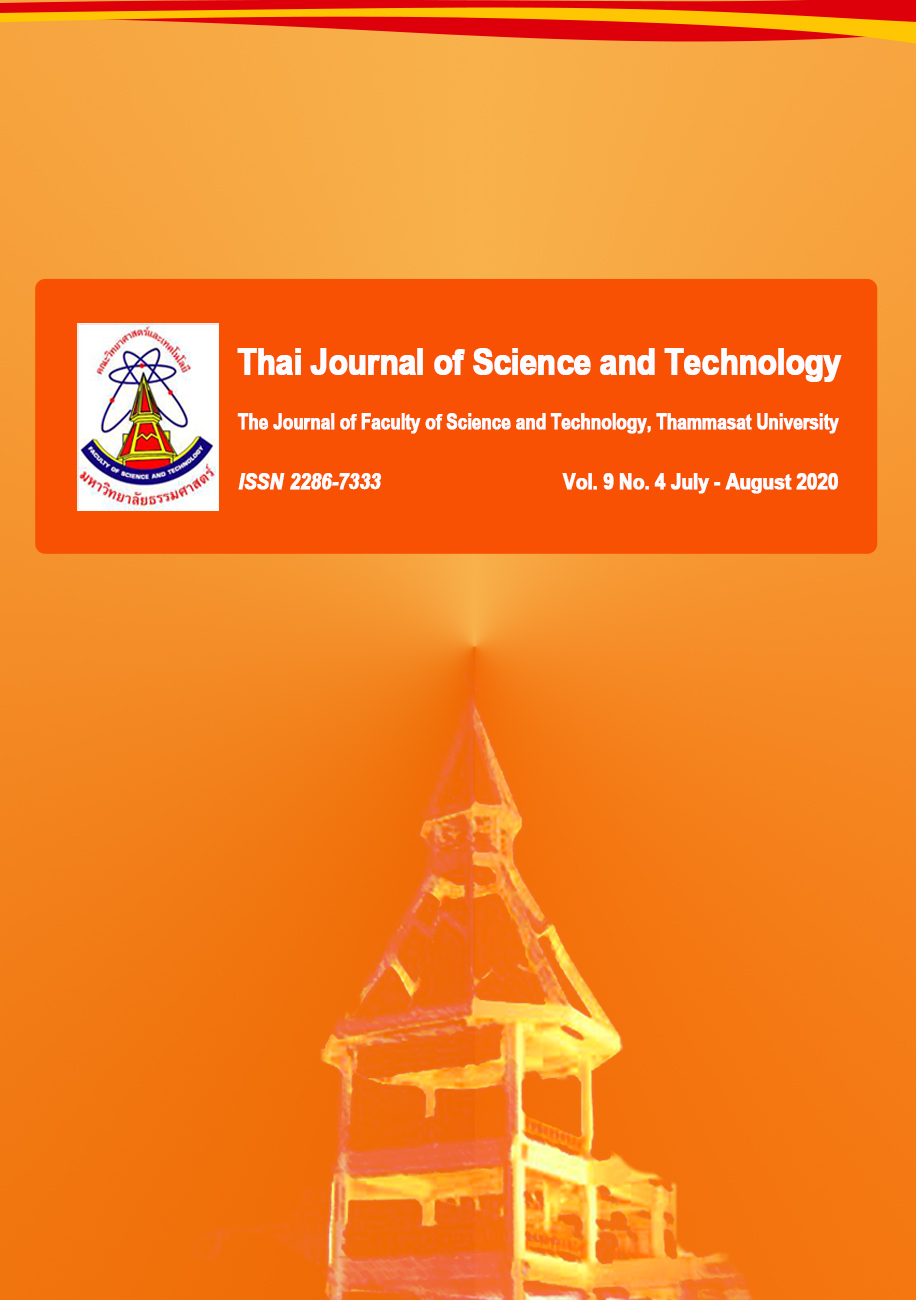ความหลากหลายของไลเคน ณ โป่งน้ำร้อนท่าปาย อำเภอปาย จังหวัดแม่ฮ่องสอน
Main Article Content
บทคัดย่อ
การสำรวจความหลากหลายของไลเคนบริเวณรอบบ่อน้ำพุร้อน โป่งน้ำร้อนท่าปาย ตำบลแม่ฮี้ อำเภอปาย จังหวัดแม่ฮ่องสอน 8 เส้นทาง โดยสำรวจไลเคนบนลำต้นของต้นไม้เส้นทางละ 10 ต้น แต่ละต้นมีระยะห่าง 5 เมตร ในแนวออกจากบ่อน้ำพุร้อน รวมทั้งหมด 80 ต้น สำรวจโดยใช้กรอบขนาด 10 x 50 ตารางเซนติเมตร บันทึกรูปภาพไลเคน ลักษณะไลเคน และบันทึกข้อมูลทางกายภาพ ได้แก่ ขนาดเส้นรอบวงต้นไม้ ลักษณะผิวเปลือกไม้ และทิศทางของลำต้นที่มีจำนวนไลเคนมากที่สุด พบว่ามีไลเคนทั้งหมด 24 วงศ์ 38 สกุล ประกอบด้วยไลเคนกลุ่ม foliose จำนวน 2 วงศ์ 3 สกุล และไลเคนกลุ่ม crustose จำนวน 22 วงศ์ 35 สกุล เมื่อวิเคราะห์ความสัมพันธ์ระหว่างจำนวนไลเคนกับลักษณะผิวเปลือกไม้พบว่าไลเคนสกุล Lepraria, Pertusaria และ Pyrenula พบบนเปลือกไม้เรียบกับขรุขระไม่ต่างกัน (p = 0.328, 0.365 และ 0.262 ตามลำดับ) ส่วน 7 สกุล ได้แก่ Arthopyrenia, Bacidia, Cryptothecia, Graphis, Letrouitia, Malmidea และ Opegrapha พบบนเปลือกไม้เรียบมากกว่าเปลือกขรุขระ (p < 0.05) และมีไลเคน 1 สกุล ที่พบบนเปลือกขรุขระมากกว่าเปลือกเรียบ คือ Diploschistes (p = 0.005) พบไลเคนทางทิศเหนือของลำต้นมากที่สุด เมื่อวิเคราะห์ความสัมพันธ์ระหว่างระยะห่างจากบ่อน้ำพุร้อนกับจำนวนสกุลและจำนวนแทลลัสของไลเคนปรากฏว่ามีความสัมพันธ์กันน้อยมาก (R2 = 0.1163 และ 0.0655 ตามลำดับ) และเมื่อเปรียบเทียบจำนวนสกุลของไลเคนเฉลี่ยในแต่ละเส้นทางการสำรวจแล้วปรากฏว่าไม่ต่างกัน (p = 0.598) นอกจากนี้เมื่อจัดกลุ่มไลเคนตามความทนทานต่อคุณภาพอากาศพบว่ามีไลเคนสกุลที่ถูกจัดในกลุ่มอากาศดีอยู่ 1 สกุล (Pamotrema) และกลุ่มทนทานและทนทานสูงจำนวน 11 สกุล
Article Details
บทความที่ได้รับการตีพิมพ์เป็นลิขสิทธิ์ของคณะวิทยาศาสตร์และเทคโนโลยี มหาวิทยาลัยธรรมศาสตร์ ข้อความที่ปรากฏในแต่ละเรื่องของวารสารเล่มนี้เป็นเพียงความเห็นส่วนตัวของผู้เขียน ไม่มีความเกี่ยวข้องกับคณะวิทยาศาสตร์และเทคโนโลยี หรือคณาจารย์ท่านอื่นในมหาวิทยาลัยธรรมศาสตร์ ผู้เขียนต้องยืนยันว่าความรับผิดชอบต่อทุกข้อความที่นำเสนอไว้ในบทความของตน หากมีข้อผิดพลาดหรือความไม่ถูกต้องใด ๆ
References
Dahlkild, A., Kaellersjoe, M., Lohtander, K. and Tehler, A., 2001, Photobiont diversity in the Physciaceae (Lecanorales), Bryologist 104: 527-536.
Fernández-Mendoza, F., Domaschke, S., García, M.A., Jordan, P., Martín, M.P. and Printzen, C., 2011, Population structure of mycobionts and photobionts of the widespread lichen Cetraria aculeate, Mol. Ecol. 20: 1208-1232.
Hawksworth, D.L. and Hill, D.J., 1984, The Lichen-Forming Fungi, Chapman and Hall, New York.
Hawksworth, D.L. and Rose, F., 1970, Qualitative scale for estimating sulphur dioxide air pollution in England and Wales using epiphytic lichens, Nature 227: 145-148.
Jahrat, W., 2003, Chemical property of hot spring in Thailand, Academic report, Department of Mineral Resource, Bangkok, 80 p. (in Thai)
Jariangprasert, S., 2014, Preliminary lichen, Maejo University, Chiang Mai. 323 p. (in Thai)
Johansson, P., Rydin, H. and Thor, G., 2007, Tree age relationships with epiphytic lichen diversity and lichen life history traits on ash in southern Sweden, Ecoscience 14: 81-91.
Kanjoem, R., 2009, Lichen diversity and monitoring of sulphur dioxide around Mae Moh power plant area, Mae Moh district, Lampand province, in 2009, Master Thesis, Chiang Mai University, Chiang Mai, 98 p. (in Thai)
Karnchanawanich, S., 2010, Air Detective: Handbook of Lichen in Bangkok, Green World Foundation, Bangkok, 112 p. (in Thai)
Marmor, L. and Randlane, T., 2007, Effects of road traffic on bark pH and epiphytic lichens in Tallinn, Folia Cryptogamica Estonica 43: 23-37.
Muggia, L., Vancurova L., Škaloud, P., Peksa, O., Wedin, M. and Grube, M., 2013, The symbiotic playground of lichen thalli – A highly flexible photobiont association in rock-inhabiting lichens, FEMS Microbiol. Ecol. 85: 313-323.
Muggia, L., Perez-Ortega S., Kopun, T., Zellnig, G. and Grube, M., 2014, Photobiont selectivity leads to ecological tolerance and evolutionary divergence in a polymorphic complex of lichenized fungi, Ann. Bot. 114: 463-475.
Muangsan, N., 2013, Diversity of Lichen Species in Community Forest and Ancient Momuments of Nakhon Chai Bu Rin, Research Report, Suranaree University, Nakhon Ratchasrima, 105 p. (in Thai)
Nimis, P.L. and Purvis, O.W., 2002, Monitoring lichens as indicators of pollution, pp. 7-10, In Nimis, P.L., Scheidegger, C. and Wolseley, P.A. (Eds.) Monitoring with Lichens – Monitoring Lichens, NATO Science Series (Series IV: Earth and Environmental Sciences), Vol. 7, Springer, Dordrecht.
Nimis, P.L., Scheidegger, C. and Wolseley, P., 2002, Monitoring with Lichens – Monitoring Lichens, NATO Science Series (Series IV: Earth and Environmental Sciences), Vol. 7, Springer, Dordrecht, 407 p.
Peksa, O. and Skaloud, P., 2011, Do photobionts influence the ecology of lichens?: A case study of environmental preferences in symbiotic green alga Asterochloris (Trebouxiophyceae), Mol. Ecol. 20: 3936-3948.
Rambold, G., Friedl, T. and Beck, A., 1998, Photobionts in lichens: possible indicators of phylogenetic relationships?, Bryologist 101: 392-397.
Saipunkaew, W., Wolseley, P.A. and Chimonides, P.J., 2005, Epiphytic lichens as indicators of environmental health in the vicinity of Chiang Mai city, Thailand, Lichenologist 37: 345-356.
Saipunkaew, W., Wolseley, P.A., Chimonides, P.J., and Boonpragob, K., 2007, Epiphytic macrolichens as indicators of environmental alteration in northern Thailand, Environ. Pollut. 146: 366-374.
Silprasit, K., Duangjai, W., Ngamniyom, A., Kroeksakul, P., Thumajitsakul, S., Sriyapai, T. and Tuntates, U., 2013, Diversity of lichen surrounding nature - based tourism area in Khun Dan Prakan Chon Dam, Nakhon Nayok Province, Thai J. Forest. 32(Supplementary): 85-96. (in Thai)
Thor, G., Johansson, P. and Jönsson, M.T., 2010, Lichen diversity and red-listed lichen species relationships with tree species and diameter in wooded meadows, Biodiv. Conserv. 19: 2307-2328.
Vargas Castillo, R. and Beck, A., 2012, Photobiont selectivity and specificity in Caloplaca species in a fog-induced community in the Atacama Desert, North Chile, Fungal Biol. 116: 665-676.
Verein Deutscher Ingenieure (VDI), 1995, VDI 3799 Part 1, Measurement of Immission Effects, Measurement and Evaluation of Phytotoxic Effect of Ambient Air Pollution (Immission) with Lichen: Mapping of Lichen for Assessment of the Air Quality, Verein Deutscher Ingenieure, Dusseldorf.
Werth, S. and Sork, V.L., 2010, Identity and genetic structure of the photobiont of the epiphytic lichen Ramalina menziesii on three oak species in southern California,
Am. J. Bot. 97: 821-830.
Wirtz, N., Lumbsch, H.T., Green, T.G.A., Türk, R., Pintado, A., Sancho, L. and Schroeter, B., 2003, Lichen fungi have low cyanobiont selectivity in maritime Antarctica, New Phytol. 160: 177-183.
Wolseley, P.A. and Aguirre-Hudson, B., 1997, The ecology and distribution of lichens in tropical deciduous and evergreen forests of northern Thailand, J. Biogeo. 24: 327-343.
Yahr, R., Vilgalys, R. and de Priest, P.T., 2006, Geographic variation in algal partners of Cladonia subtenuis (Cladoniaceae) highlights the dynamic nature of a lichen symbiosis, New Phytol. 171: 847-860.

